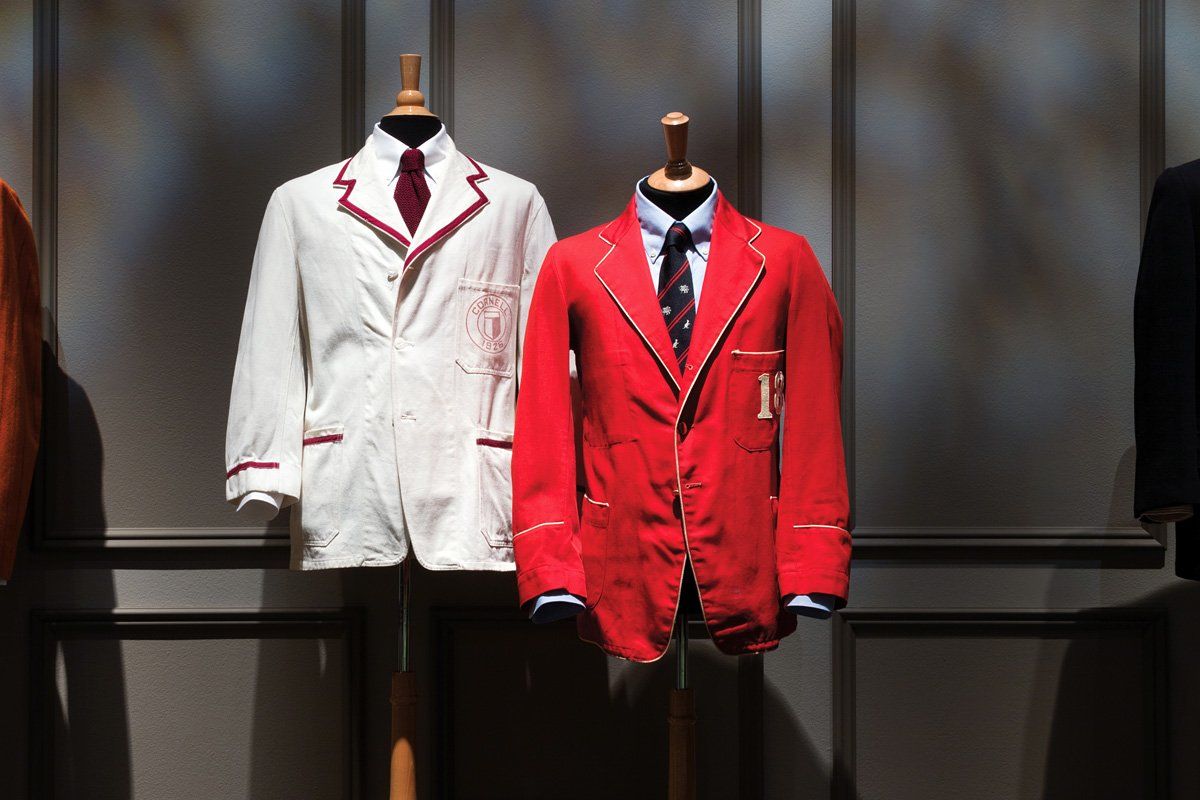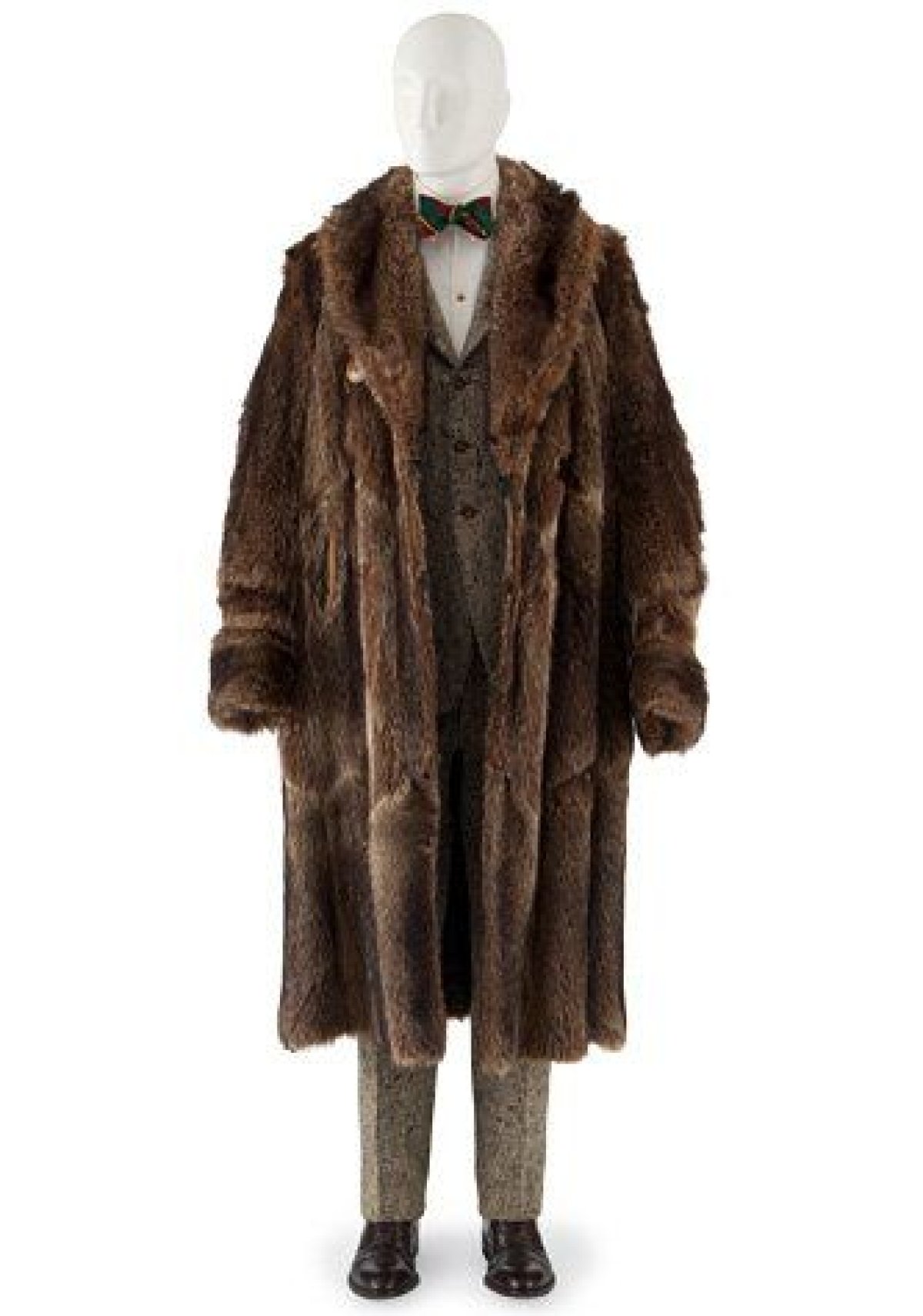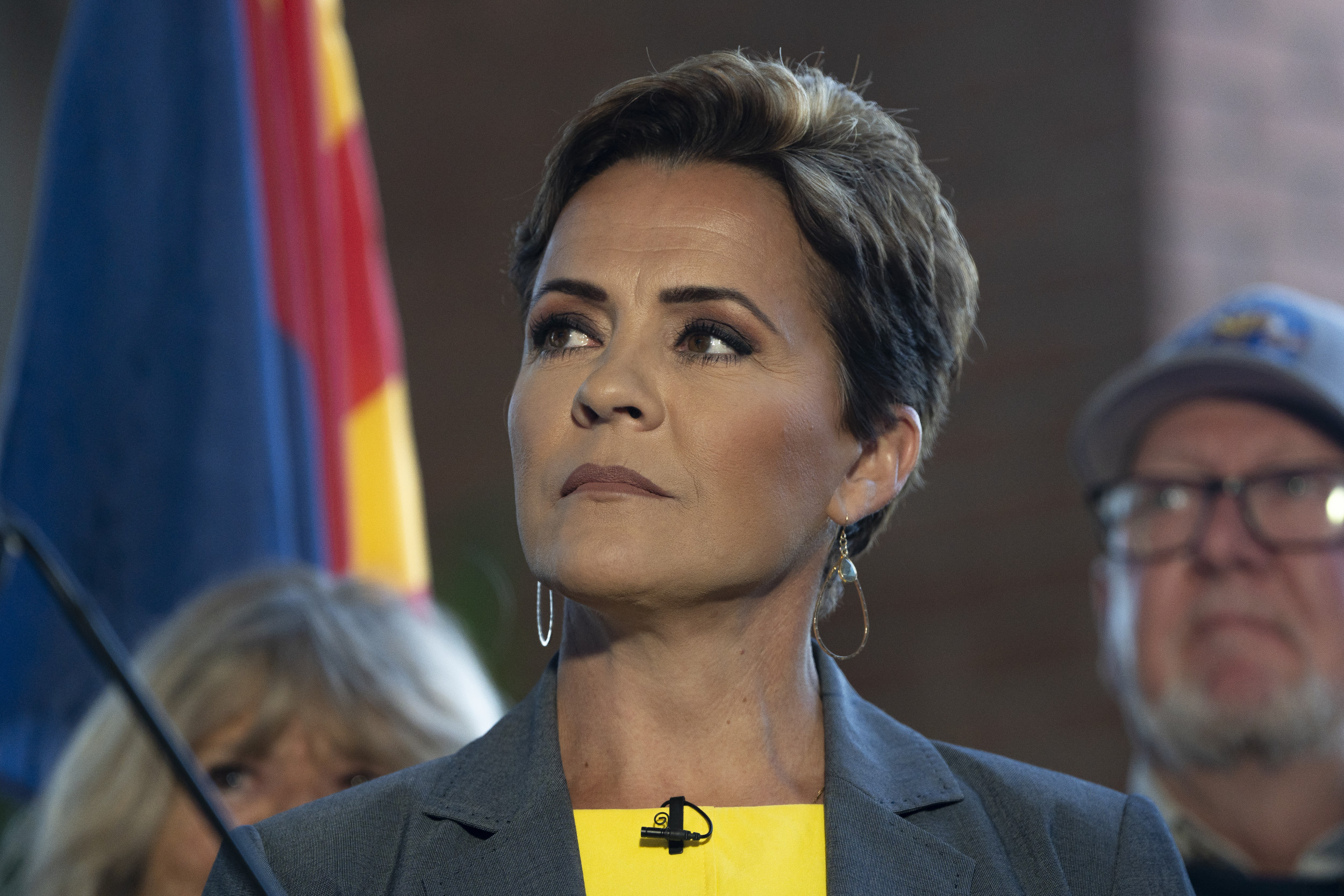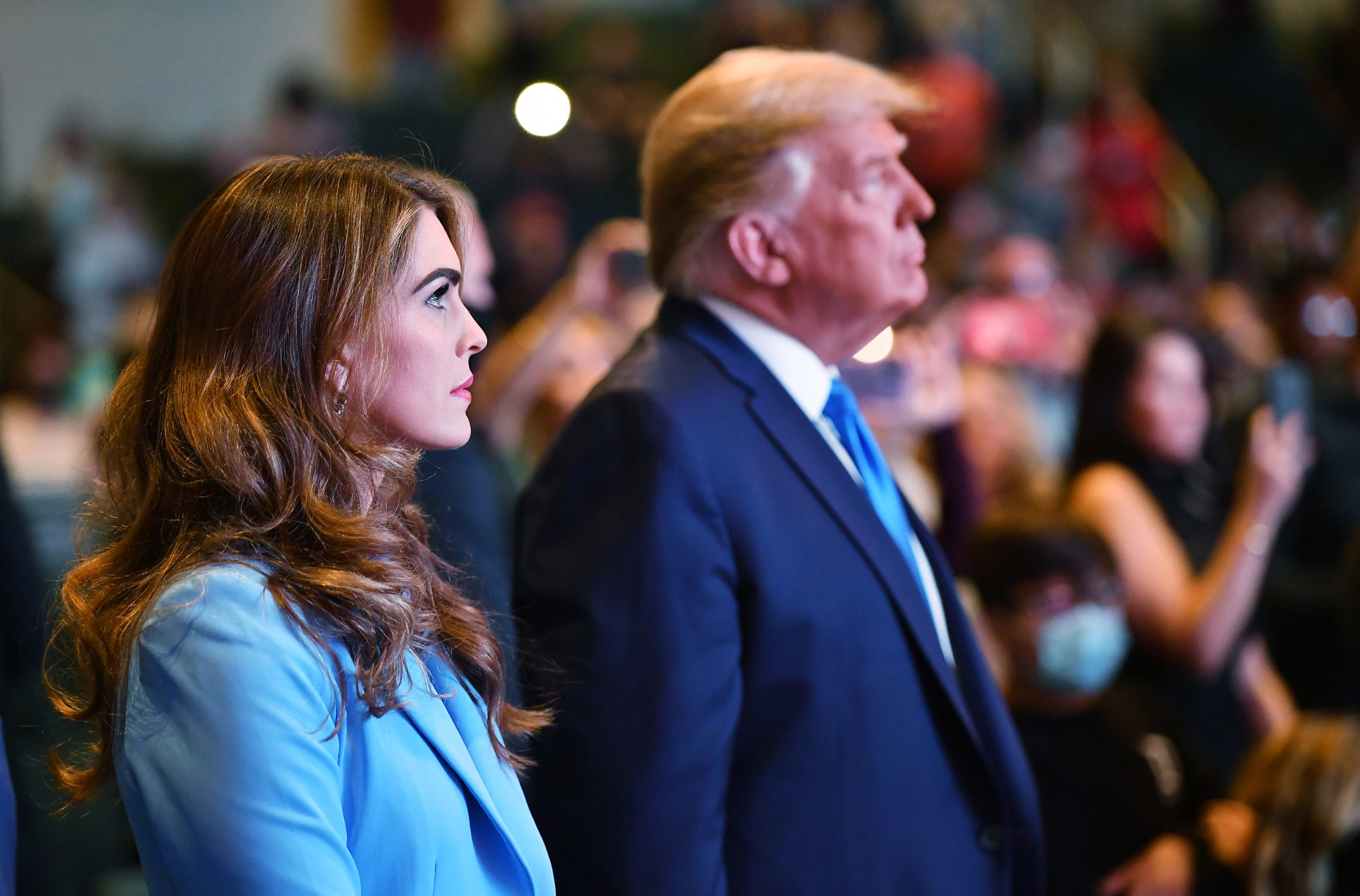
"I think of all Harvard men as sissies," says Amory Blaine, the alter-ego of Princetonian F. Scott Fitzgerald in This Side of Paradise. "All Yale men wear big blue sweaters and smoke pipes," while Princeton boys are "lazy and good-looking and aristocratic."
Blaine, like most of Fitzgerald's protagonists, aspires to the gentleman's life, which naturally includes an Ivy pedigree. On the leafy quads and football fields of the elite eight in America's prewar years, young men of means learned to philosophize and compete, to drink, to dance—and most of all, to dress. Tweed suits, sporty blazers, and polo coats all formed the classic repertoire of an Ivy wardrobe—a style fully celebrated this fall at the Fashion Institute of Technology, in a delightful museum exhibit running through Jan. 5.
Sponsored by Brooks Brothers, the exhibition focuses mostly on menswear and brings together more than 60 looks to present the evolution of "Ivy style" through the ages, as it spread beyond the citadels of New Haven and Cambridge to give birth to a distinctly American preppy look. Mannequins sporting madras shirts and Weejun loafers lounge languidly on a grass-covered quadrangle, or pose in front of a mock frat house. Lusty fight songs boom out over the speakers in a jaunty collegiate soundtrack.
The sartorial look known as Ivy was born between the great world wars, with Princeton at its epicenter. The school had a reputation as the wealthiest and most stratified of the exclusive all-male universities, a bastion of Protestant manners and conservative politics. (One dandy called it "the best Southern school in the North.") From its golf clubs and tennis courts came Shetland suits, V-neck sweaters, and buckskin footwear—the progenitors of saddle shoes. Its crew team popularized the crested blazer, and legend has it that the modern sport jacket emerged there, too, when one clever fellow thought to pair a Norfolk hunting jacket with non-matching trousers.
The preeminence of athletics in the genesis of Ivy style is evident throughout the exhibit. The 1920s and '30s were the "age of the gentleman athlete," when Douglas Fairbanks and the Duke of Windsor were hailed as fashion icons and the phrase "Ivy League" emerged in popular media to describe the schools' sporting competitions. (In an alternate etymology, Harvard, Princeton, Columbia, and Yale convened in 1876 to set some ground-rules for college football, branding their conference with the Roman numeral IV.) The exhibit devotes a special section to letter sweaters and class blazers from the early part of the century, including James Stillman Rockefeller's '24 Yale sweater and the 1916 blazer of his fellow Eli, Warren Scripps Booth, later the publisher and chairman of The Detroit News. There's a '26 Cornell reunion blazer with faded maroon piping, and a beautiful black-and-orange specimen from the Princeton class of '23, sporting the Dei Sub Numine Viget on its breast.
Though blazers quickly became synonymous with Ivy style, they first hailed from Britain, worn by members of a Cambridge rowing club as early as 1825 (the name comes from the original garment's flaming red cloth). In fact, the Ivy boys borrowed many of their vintage looks from the Oxbridge aristocrats across the Atlantic: tweed jackets; double-breasted polo coats originally used by British teams as "wait coats" on the field.
Such outerwear was an essential part of a proper university wardrobe—but a stylish upperclassman or frosh would also need several suits, including at least two formal ones for eveningwear. According to the 1937 "Back to School" issue of menswear mag Apparel Arts, a herringbone Shetland suit promised to convey "the right mixture of conservatism and individuality," while a fancy soiree called for a midnight blue tailcoat and white muffle, accessorized with gloves, an opera hat, and a "red carnation." During leisure time, the fashionable favored seersucker lounging robes and velvet loafers embroidered with pitchforked devils and migrating mallards. And during a particularly heady moment in the 1920s, no student could consider himself fully dressed without a raccoon coat, a trend that inspired a hit Rudy Vallee song ("Doin' the Raccoon") and that lead one Princeton paper to note that furs on campus were "thick as flies."

Before World War II, Ivy fashion vogues—like the raccoon craze—only occasionally percolated out into the wider culture. But with the advent of the GI Bill in 1944 and the influx of veterans into higher education, Ivy style took off with the masses. Merchants such as J.Press, Chipp, and Gant set up "university shops" in department stores to peddle penny loafers and gray-flannel suits. Of all the firms, J.Press was the most successful—founded on the Yale campus in 1902 by a Jewish Lithuanian immigrant, it crafted the distinct Ivy look: natural-shoulder suits; sport coats in cashmere, mohair, and Harris tweed; glen plaid. For the more daring, Chipp made its name with summery sherbet hues of coral and lemon yellow, checkered together on madras jackets and Shetland sweaters. Meanwhile, America's burgeoning middle classes not only adopted the Ivy look—they influenced the style in turn. Khakis, a pant first used in U.S. military uniforms of the late 19th century, quickly became a staple of college boys—many of them former GIs themselves—in the 1950s and beyond.
In an exhibit full of understated looks, the collegiate clothes of the '60s and '70s are slightly deviant. Weird, wild, and wonderful pieces abound: corduroy pants in Christmas colors, one leg red and one green; red-and-white seersucker shorts; a patchwork Tartan jacket from '74 that looks like a set piece out of an Edward Albee play.
But those decades also saw the decline of Ivy style in popular culture—a trend that wouldn't reverse until the 1980s, when all things preppy came roaring back into fashion. The renaissance owed itself in no small part to American designer Ralph Lauren, a man whom the exhibit terms "the Ivy crusader." His signature look from the spring 1980 show—blue oxford button-down, flat-front chinos, striped suspenders, brown-and-white saddle shoes—is now iconic as the uniform of choice for Reagan-era Wall Street bankers and WASPy trust-funders. But at the time, it was considered a revolutionary new direction for fashion—and the term "preppy" began to signify a wider style untethered from the Ivies and the preparatory schools that fed them; one that now included women's fashion, too.
Still, Lauren and others continued to draw inspiration from, and pay loving homage to, the interwar Ivy men's style. "When I was a young man going to college, I always loved the Ivy League look—its ease and tradition," Lauren once said. Jeffrey Banks—who became Lauren's protégé before launching his own line—honored traditional tailoring techniques in his tartan sport coats and tweed suits; Michael Bastian injected the look with a "deep woods" aesthetic: tan cable sweaters, blue corduroys, hunting shoes. Perry Ellis combined high-fashion proportions and classic tweedy materials. And the master himself has stayed deeply devoted to the Ivy style's timeless elegance. Lauren's handsome tuxedo and evening-coat ensemble from his fall 2012 collection rivals the best looks from Princeton's heyday, while his fall 2002 mix of dark herringbone jackets and Fair Isle vests would be at home at a Crimson football rally in any era.
Preppy style today is alive and well, as the exhibit reminds us—both on the Ivy campuses and off, peddled by luminaries such as Lauren and turned into a big moneymaking business by designers such as Tommy Hilfiger. It evokes classic Americana, casual wealth, the optimism and ease of a nation on the ascent (regardless of how the economy is actually doing these days). It is ubiquitous even in Japan, where designer Thom Browne's slim, shrunken flannel suits and polished wing tips are de rigueur. Browne—who was honored this year with the Cooper-Hewitt award—may be as influenced by Ivy style as Lauren, but tends to use the look as a springboard into cheeky flights of fancy. He tarts blazers up in pastel pink and green; peppers plaid pants with toothy spikes on the crotch and thighs; balloons a letterman's sweater to massive, steroidal proportions. Not a look that one would find in the annals of Ivy history, perhaps, but sure to find a fan base among the Bright Young Things of today.
Uncommon Knowledge
Newsweek is committed to challenging conventional wisdom and finding connections in the search for common ground.
Newsweek is committed to challenging conventional wisdom and finding connections in the search for common ground.
About the writer
To read how Newsweek uses AI as a newsroom tool, Click here.








